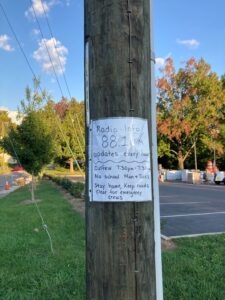The 2024 Atlantic hurricane season has been one of the most devastating in recent history. Residents affected by Hurricanes Helene and Milton turned to one of the only reliable sources of information available: their local public media stations.

Emergency radio broadcast information. Photo credit: Blue Ridge Public Radio.
At the epicenter of this disaster was Asheville’s Blue Ridge Public Radio (BPR), a small, rural station broadcasting on 88.1 FM, online, and through streaming. While many other news sources lost power and internet, BPR remained online, bringing lifesaving news and information to the over 500,000 people who lacked power in the region. Amid these outages, residents listened to day-long live coverage of local county and regional briefings, interviews with local officials and affected residents, and analysis of the recovery. The station partnered with a local news nonprofit to translate county briefings into Spanish, an essential service for Spanish-speaking residents. With spotty Internet and cell service, the station rapidly created a text-only version of its website accessed easily with low bandwidth, endorsed by the North Carolina Attorney General as a resource for affected communities.
BPR’s efforts reflected public media’s collaborative spirit. The station lent its space to reporters from the Charlotte Observer, Associated Press, New York Times, and NPR. Reporters affiliated with NPR’s Collaborative Journalism Network — as far away as California and Alaska — signed up to volunteer in shifts for digital, social media, and audio editing support. BPR also received support from the North Carolina Public Radio Association (NCPRA) and Public Media Journalist Association (PMJA) Editor Corps, a rapid response editing service supported by Corporation for Public Broadcasting (CPB) grants.
PBS North Carolina was instrumental in filming and distributing the Governor’s emergency briefings. As roads reopened, PBS North Carolina’s editorial teams captured the Governor’s visits to Western North Carolina for nightly news press pool footage, on-the-ground recovery stories for a Black Issues Forum special and for future local programming. Leveraging its extensive digital networks, PBS North Carolina connected residents with vital resources. The statewide public television network’s upgraded NEXTGEN TV signal ensured reliable distribution of emergency alerts and warnings.
In Florida, the Florida Public Radio Emergency Network (FPREN), a collective of 14 public media stations reaching 99% of Florida’s population, began tracking Helene a week before its ‘Big Bend’ landfall, collaborating with the Florida Division of Emergency Management. Supported by the state and CPB, FPREN delivers highly targeted public safety and weather information, issuing news and weather alerts across all platforms, including an app, to reach residents wherever they are ahead of major storms. When Hurricane Milton made landfall days later, FPREN again activated, providing real-time information in English and Spanish.
Milton pounded the Tampa area, a region served by WUSF and WEDU PBS, with torrential rain, high winds, tornadoes, and flooding. Like with Helene, the public media system supported WUSF’s 24-hour response to the storm, with volunteers from stations and national organizations offering editing support for news, digital media, and broadcast. WUSF hosted live call-in shows, aired frequent local news briefings, and maintained a regularly updated live blog with a text-only, low bandwidth option to keep residents informed and safe before and after the storm. Following the storm, the station continued to provide essential information for residents about boil-water notices, city transportation routes, school closures, and more.
WEDU PBS remained on-air through power outages to deliver critical emergency resources across all platforms. After the storms, WEDU PBS provided extensive recovery resources, including a Florida This Week hurricane special, segments on homeowners’ insurance, and messages thanking first responders. Partnering with Tampa Theatre, WEDU PBS hosted “Community Comfort” events for families featuring PBS Kids programming and charging stations and collaborated with Feeding Tampa Bay on food drives to aid hurricane-affected families.
WUCF in Orlando sent a pre-storm community communication with emergency resources and aired the Governor’s briefings. Through their Meet the Helpers initiative, which introduces children to emergency responders to reduce fear and improve crisis responses, WUCF provided caregivers with trusted resources to discuss Hurricane Milton. WGCU in Fort Meyers shared essential updates on shelters, evaluations, and resources across platforms. When Hurricane Milton intensified, WGCU paused regular programming to provide nonstop live coverage, keeping listeners safe and informed. Both stations offered timely updates in local newscasts focused on impact stories, local and statewide emergency management communications, and local resources for recovery.
Without CPB funding and consistent Congressional support for nearly 50 years, these lifesaving services would not be available. Every day, public media stations act as strong community partners offering local news, entertainment, children’s educational programming, noncommercial music, and more. But when disasters strike, these same stations become first responders. As the communities affected by these storms begin the long process of rebuilding, their public media stations will be with them every step of the way.
Featured image: An American flag still stands after Hurricane Milton destroyed several homes on Manasota Key. Photo credit: WGCU.

Follow Us